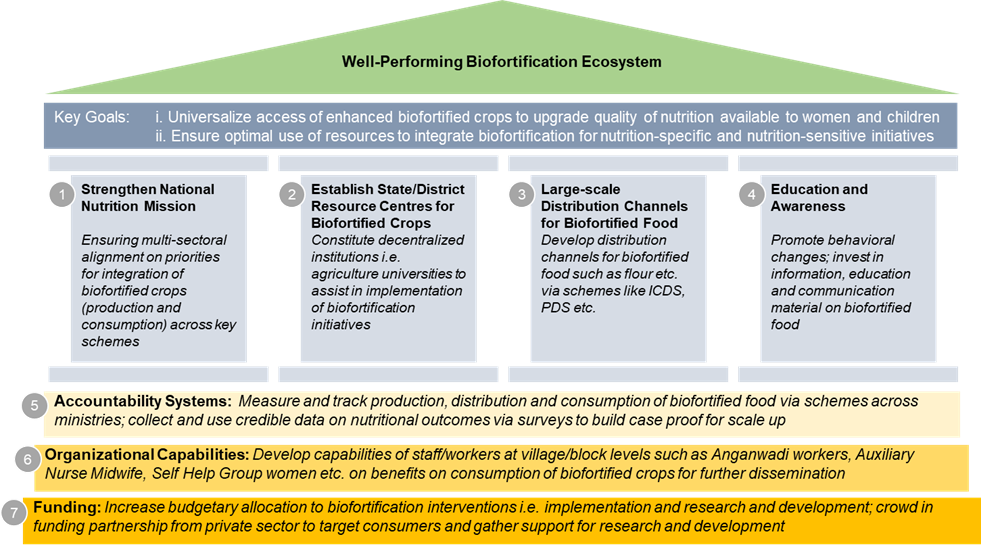
Nutrition is an important human right, especially for some of the most vulnerable groups in society i.e. women, girls, children, who have passed through an inter-generational cycle of multiple forms of deprivation. The intergenerational cycle of undernutrition of these groups, manifest as low birth weight, is compounded by gender discrimination and social exclusion.
Nutrition is the foundation for human development given its ability to reduce susceptibility to diseases, infections, comorbidities, the incidence of death and enhance learning capabilities and work productivity. Access to proper nutrition is critical to ensure better learning outcomes in education, healthy human capital in the workforce and more equitable society.
India faces a development paradox—of being one of the fastest-growing global economies in the world and contrast—of having an estimated 189.2 million people i.e. 14% of the population as undernourished. Further, the percentage of children under the age of five who are stunted, wasted and are underweight are 38.4, 21.0 and 42.5 respectively. Also, 53.1% of women of reproductive age between 15 to 49 years are Anaemic. These metrics highlight the prevalence of chronic malnourishment of women, girls and children in India.
Furthermore, COVID-19 has exacerbated the malnutrition status of vulnerable communities in India weakening their immunity.
The rate of improvement in nutritional status has not kept pace with India’s significant gains in economic prosperity and agricultural productivity during recent decades. Stunting rates are likely to decline with economic progress, but economic growth cannot, by itself, reduce under-nutrition. More often, the burden of malnutrition is attributed to poverty, inequality and food shortage.
The aforementioned index has three indicators out of four that deal with nutrition which emphasises the fact that India needs to go beyond just stomach-filling or meeting calories’ requirements. The crisis of malnourishment requires the provision of food with required nutrients i.e. micronutrients. It needs a leap in solving for Hidden Hunger, and not be confined to Hunger.
The issue calls for a paradigm shift in policy focus from approaches that tackle hunger through supplements, food provision via public distribution systems etc. towards improvement in the quality of food being consumed. One of the first steps is for policymakers/advisors to understand how nutrition security is the bigger whole of which food security is a part. Furthermore, it is important to think of a shift that is time and resource-efficient.
Biofortification, an agriculture-based approach to the development and dissemination of micronutrient-rich crops, offers a viable option to mitigate malnutrition and hidden hunger. The solution majorly targets poor and rural people who grow and consume staple crops significantly and supply their surplus produce majorly within their community. The method enriches staple crops with required micronutrients that reduces people’s nutritional vulnerability because, during economic shocks, the poor tend to reduce their consumption of higher-value food commodities that are naturally rich in micronutrients. With a one-time research and development investment, biofortified seeds can spread through the existing seed distribution systems in the country. Farmers, even with limited resources and market access, can grow biofortified crops since they do not need repeated purchases of seeds year after year—they can use a part of their produce as the seeds for the next year.
Moreover, an increase in the adoption of seeds through efficient seed distribution channels will ensure it is economically remunerative for the growers. For consumers, awareness has to be created about subsequent health benefits while ensuring easy access and affordability of the produce.
Currently, there is sufficient evidence available to say that biofortification can improve nutritional outcomes e.g. improvement in haemoglobin and total body iron in Rwanda women after consumption of biofortified iron bean, enhancement in serum ferritin and total body iron observed in iron-deficient adolescent boys and girls in Maharashtra, India after consuming biofortified pearl millet flatbread twice daily for four months etc.
The Government of India has already taken an important step in linking agriculture and nutrition with biofortification. Prime Minister Narendra Modi has given a strong endorsement to staple crop biofortification as a sustainable and cost-effective solution to alleviate malnutrition. On World Food Day 2020, the Prime Minister noted that common varieties of some crops lack key micronutrients that are essential for good health, and thus biofortified varieties were developed to overcome these shortcomings. He also dedicated to the nation 17 recently-developed biofortified seed varieties of eight local and traditional crops, including wheat and paddy rice, that are being made available to Indian farmers. He said, “We are taking an important step in our fight against malnutrition as we are now encouraging the production of crops which are rich in nutritional substances like protein, iron, zinc etc.”
These biofortified varieties, along with other food ingredients, are expected to transform the normal Indian thali into Nutri-thali. These varieties have been developed by utilizing the local landraces and farmer’s varieties. Further, to encourage biofortification amongst farming communities, Indian Council for Agricultural Research (ICAR) has started the Nutri-Sensitive Agricultural Resources and Innovations (NARI) programme for promoting family farming linking agriculture to nutrition, nutri-smart villages for enhancing nutritional security and location-specific nutrition garden models are being developed and promoted by Krishi Vigyan Kendras (KVKs) to ensure access to locally available, healthy and diversified diet with adequate macro and micronutrients.
Although the first step towards this viable option has been taken, India needs a comprehensive, integrated plan for scaling up the development and consumption of biofortified crops striving at nutrition security for its citizens. It needs a multi-year integrated approach for ensuring a well-performing biofortification ecosystem.

This blog has been authored by Guriya.
- http://niti.gov.in/writereaddata/files/document_publication/NutritionStrategyBooklet.pdf
- http://www.fao.org/3/ca9692en/ca9692en.pdf
- http://rchiips.org/nfhs/pdf/NFHS4/India.pdf
- https://www.downtoearth.org.in/blog/health/child-malnutrition-in-india-a-systemic-failure-76507
- https://www.ifpri.org/blog/biofortification-plausible-antidote-indias-hidden-hunger-problem
- https://poshan.outlookindia.com/story/india-news-indias-hunger-index-what-can-be-done/326676
- https://academic.oup.com/jn/article/146/8/1586/4584652
- https://academic.oup.com/jn/article/145/7/1576/4644387
- https://pib.gov.in/PressReleasePage.aspx?PRID=1664231






